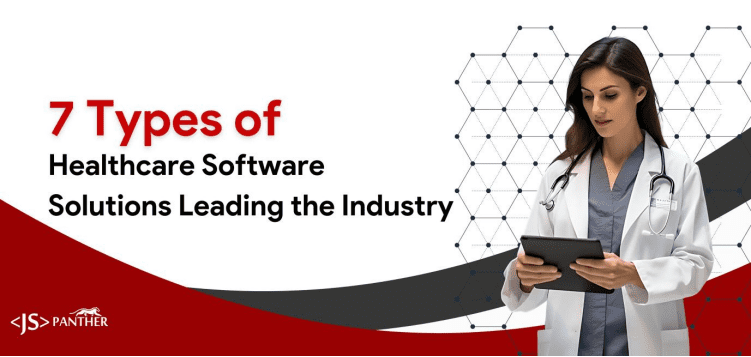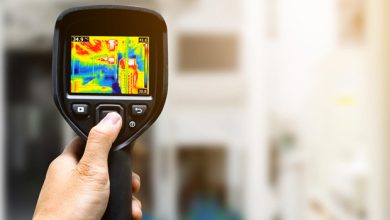7 Types of Healthcare Software Solutions Leading the Industry

The global healthcare IT market is expected to cross $974.5 billion by 2027 and grow at a CAGR of 19.8% from 2022 to 2027. With the advancements of telemedicine and AI, healthcare software development is witnessing new and innovative applications every now and then.
Medical institutions are proactively adopting healthcare software solutions that adhere to regulatory compliances and help them with patient monitoring, running daily operations, etc.
This article discusses the main types of software used by hospitals and individuals to handle activities concerning health and medication.
Here are 7 Major Types of Healthcare Software
1. Electronic Health Records (EHRs)
What is it- As the name suggests, an EHR is a digital storage system for collecting, storing, and accessing patient health information. An electronic health record software is of two types:
- Electronic patient record software (EPR): Hospitals and medical institutions use EPR to store and process patient data.
- Electronic medical record software (EMR): An EMR is more complex and allows the storage of medical records, ongoing drugs and dosages, a complete history of patient health, and more.
Electronic health records are among the most prevalent healthcare software solutions. They help hospitals reduce their workload and provide a centralized system for doctors to assess patient health.
Complex EHR solutions can also include medical invoicing, on-demand consultation, prescription refilling, and more.
Renowned EHR Vendors: Epic Systems Corporation, Oracle Cerner, MEDITECH, etc.
Standard Features of EHR Systems:
- Patient charts and records
- HIPAA-compliant messages
- Administrative processes and reporting
- Reporting and population health
- E-prescriptions
2. Telemedicine Software
What is it- Telemedicine software are web and mobile apps that allow patients to consult with doctors through audio and video conferencing. These apps can also contain billing and e-prescription modules for smooth remote patient monitoring.
Globally, there has been a significant rise in the adoption of such software Post-Coronavirus Outbreak. As per a report by MarketsandMarkets, the telemedicine revenue is expected to cross 285.7 billion by 2028.
Examples of Telemedicine Apps- Amwell, Maple, LiveHealth, etc.
Standard Features:
- Patient’s Dashboard
- Doctors Catalogue
- Appointment Management
- Video/Audio/Text Consultation
- E-prescription
- Invoicing
3. Hospital Management System (HMS)
What is it- An HMS is a complex software system that allows hospitals to manage patients smoothly and perform various day-to-day activities involved in healthcare management.
Extensive hospital management software can have several features for automating repetitive procedures, like creating doctors’ schedules, updating resource availability, etc.
A custom software development company can tailor bespoke HMS that fulfills precise requirements. You can also integrate them with other medical apps to extend functional features.
Examples of HMS- Arrendale, QGenda, Caspio, etc.
Standard Features:
- Appointment scheduling
- Inventory Management
- Patient Management
- Insurance Management
- Staff Management
- Analytics & Billing
4. Medical Imaging Software
What is it- Medical imaging or visualization software helps healthcare institutions process MRI/CT/PET scans and design various types of 3D models. Such software can be of the following two types:
- Human Anatomy 3D Modeling:Medical professionals can tailor models for individual patients using this software.
- Designing and Printing Body Parts or Equipment:This software allows printing elements of medical equipment or body parts, like artificial limbs, coronary stents, etc.
Medical imaging software helps physicians interpret data gathered from radiology exams. Such data can be obtained from computer tomography (CT), magnetic resonance imaging (MRI), etc. It provides doctors with better views of organs, blood vessels, tissues, and bones.
Vendor Examples: Dicom Systems Unifier Platform, ProtonPACS
Standard Features:
- Capture, store, and display medical images
- Help with diagnosis and image-guided surgery
- Aids in treatment planning
- Visualize medical images in multiple ways
- Measure and analyze images
- Create 3D models
5. E-Prescription Software
What is it- E-prescription software allows doctors or medical professionals to electronically create and share error-free prescriptions with patients. It can be understood as a simple digitization of prescriptions.
Research shows that nearly 1.5 million people are injured due to illegible handwriting in medical charts and prescriptions. Moreover, nearly 7,000 people die every year due to poor handwriting. This showcases the demand and worth of e-prescription solutions in the healthcare software development industry.
Examples: CharmHealth, Kareo Clinical, Elation Health, etc.
Features:
- Dashboard for users
- Creating and submitting drug prescriptions
- Tracking Fulfilment
- Refill Requests
- Medical History
6. Health Tracking Apps
What is it? Tracking apps help users monitor their calories, water, sleeping patterns, and more to achieve desired health or fitness goals.
These apps are mostly integrated with IoT-enabled healthcare wearables like smartwatches, wristbands, etc., which makes them popular among users. They can be of various types, but the most popular ones are based on diet, meditation & stress reduction, and fitness.
Examples: MyFitnessPal, Google Fit, Apple Health, etc.
Features:
- Goal Settings
- Create custom diet plans
- Push Notifications
- Social Media sharing option
7. Healthcare Supply Chain Management Systems
What is it- A supply chain management software allows medical institutes to manage the procurement, storage, and distribution of medical supplies and equipment.
They enhance the key operation’s efficiency and cost-effectiveness by streamlining tasks like order management, inventory management, delivery tracking, etc.
You can also integrate them with medical equipment management software to ensure adequate supplies. Healthcare professionals view them as the very soul of the smooth running of hospitals.
Vendor Examples: Oracle, Tecsys Inc., Global Healthcare Exchange, etc.
Features:
- End-to-end integration of the process
- Real-time collaboration
- Standard optimization
- Cloud-based accessibility
- Analytics & forecasting
Wrapping Up
The digitization of the healthcare industry leads to high efficiency and cost reduction. They also enable hospitals to deliver world-class patient care with comprehensive medical services.
At JS Panther, we can help you transform ideas into viable healthcare apps and solutions. We specialize in end-to-end medical software development.





